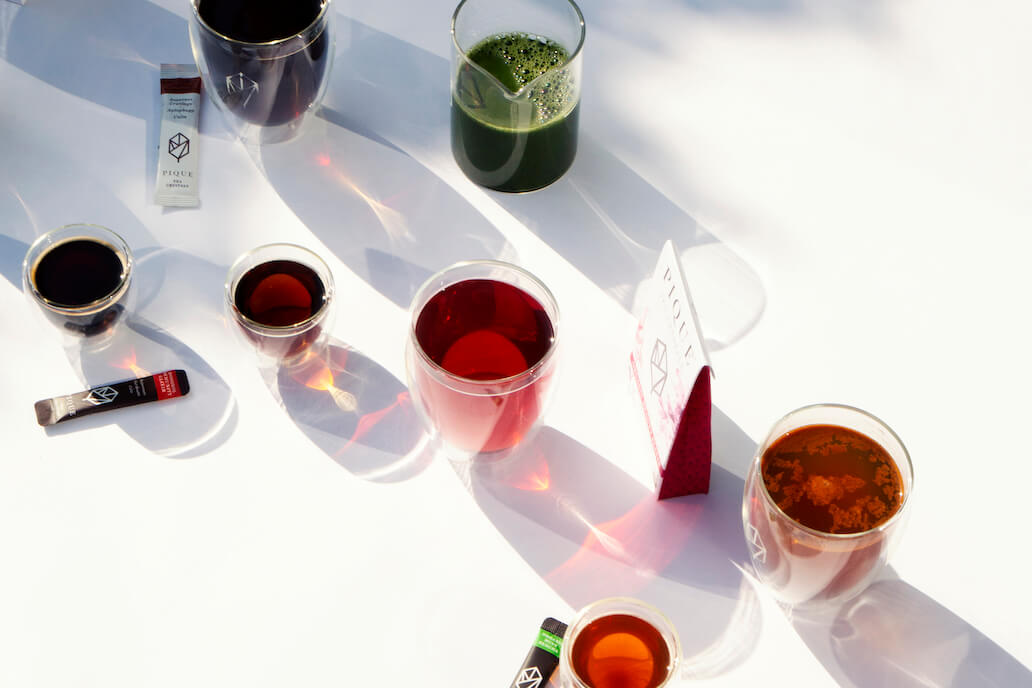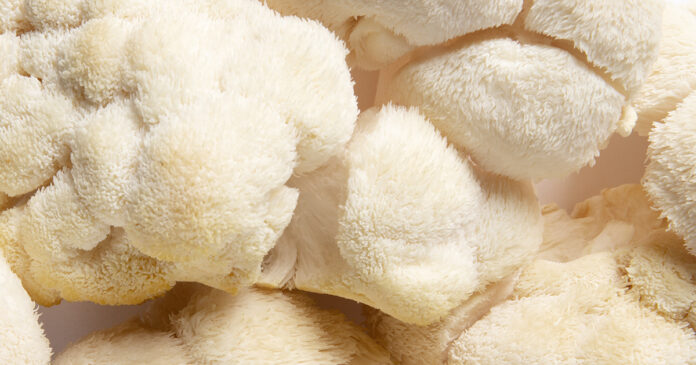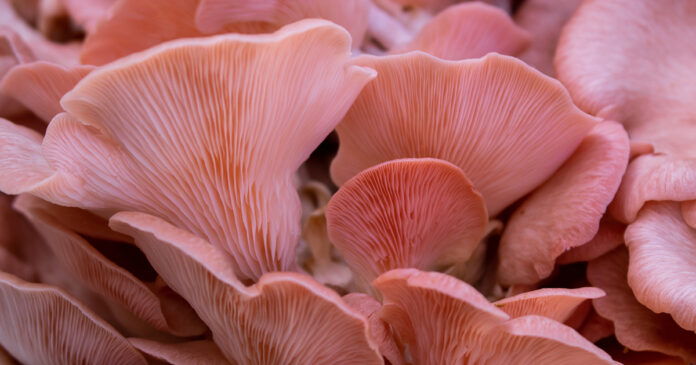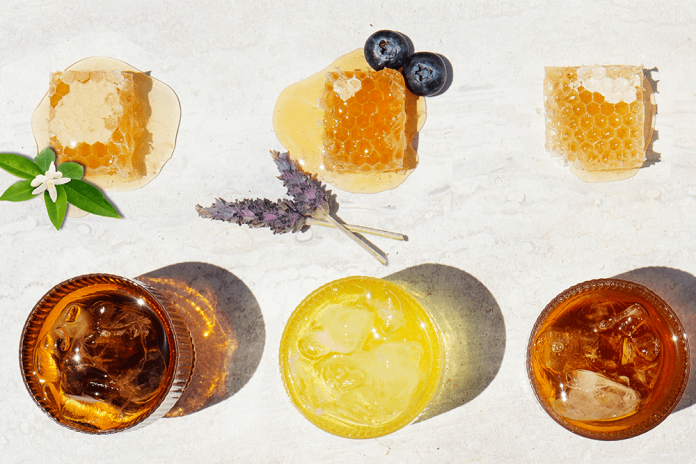There’s no doubt about it: People love tea.
After water, tea is the most consumed beverage in the entire world. In the U.S. alone, nearly 80% of all households keep a tea stash handy, and more than 159 million Americans drink tea every day. (That’s nearly half the U.S. population!)
All told, Americans consumed a whopping 84 billion servings of tea in 2018 alone. (1)
By far, black tea is the most popular brew in the U.S. (Nearly 84% of the tea consumed by Americans in 2018 was black tea.) While the dark brew has plenty of merits, it’s certainly not the only tasty and healthful tea out there.
In fact, there are many different types of tea varieties. And each one of them boasts its own origins, flavor profiles, and health benefits.
If you’re looking to expand your tea-drinking palate, you’ve come to the right place. Below, we’ve rounded up ten types of tea (both “true” teas and herbal teas) with an overview of everything you need to know to find the right brew for you.
With this guide, you’ll be steeping and enjoying different types of tea varieties in no time at all.
Healthy and Popular Types of Tea
- Black Tea
- Chamomile Tea
- Ginger Tea
- Green Tea
- Hibiscus Tea
- Mint Tea
- Oolong Tea
- Pu-erh Tea
- Rooibos Tea
- White Tea
Let’s take a closer look at each of these tasty beverages and their potential health benefits.
Different Types of “True” Teas
We’ll admit it: The world of tea can get a little snobby.
There are actually only a few tea types that carry the label of “true” tea: namely, black, green, oolong, pu-erh, and white teas. Each of these teas is made from the same tea leaves, technically called the Camellia sinensis plant, which is a requirement for a beverage to qualify as “true” tea. (2) There aren’t actually any other types of tea plants.
Tea-like beverages that aren’t produced from Camellia sinensis aren’t technically tea — but because most people think of them that way, they often get lumped under the category of “herbal tea” or “tisanes.”
There are many different types of herbal tea. In this article, we’ll focus on a few of the most popular in the form of chamomile, hibiscus, mint, and rooibos.
But first, let’s take a look at the exclusive members of the “true” tea club.
1. Black Tea
As with all “true teas,” black tea is derived from the Camellia sinensis plant. Leaves of the plant are crushed, curled, rolled, or torn and then left to oxidize before they’re dried and sold. (3)
The fact that the leaves are fully oxidized accounts for black tea’s strong, dark flavor profile. The oxidation process also decreases black tea’s flavonoid content a bit, but this brew is still loaded with beneficial properties.
Black tea is often sold in some kind of blend, which will determine its flavor profile. The season and place where a tea plant was grown will also impact its flavor. As a general rule, black tea is produced in China, India, Sri Lanka, or Nepal.
As we mentioned above, black tea is the most common type of tea (at least in the US) and comes in many varieties. Here are some of the most common types of black tea (4):
- Assam black tea, which has a malt-like flavor
- Ceylon black tea, which features bold flavor with hints of chocolate or spices
- Darjeeling, which is a more delicate form of black tea that features fruity or floral elements
- Earl Grey, which consists of black tea flavored with bergamot and/or citrus
- English Breakfast, which tends to be full-bodied and may most closely resemble Assam or Ceylon black tea in flavor
- Flavored blends with fruity or floral profiles, such as lychee or rose
- Irish Breakfast, which has a reddish color and malty flavor
- Keemum black tea, which is fruity and almost wine-like in its flavoring
- Kenyan black tea, which features a dark, slightly astringent profile
- Lapsang Souchong, which is distinguished by its smoky flavor
- Masala Chai tea, which is blended with a variety of spices such as cardamom, cloves, and peppercorns
- Yunnan black tea, which is chocolatey, malty, and perhaps spicy
Benefits of Black Tea
Black tea is steadily attracting more and more attention from researchers. While studies are still ongoing, so far research suggests black tea may (5):
- Support heart health
- Help support the body’s protection against oxidative stress (which happens when damaging free radicals are left unchecked in the body) (6)
2. Green Tea
Green tea is prepared from the fresh or withered, lightly heated or steamed leaves of the Camellia sinensis plant. (7) This preparation stops the oxidation process and accounts for green tea’s flavor profile, which is best described as light, fresh, and maybe slightly grassy.
Of course, different green teas may boast slightly different flavors, which can range from nutty to fruity to almost seaweed-like. Different flavors are usually explained by where the tea was grown as well as the specifics of how it was processed. Here are some of the most common types of green tea (8):
- Biluochun, a Chinese-style green tea with a strong aroma and vegetal, sometimes fruity taste
- Genmaicha, one of several Japanese green teas that’s often considered a lower grade of Sencha (see below). Puffed rice or sorghum are added to achieve a “toasty” flavor
- Gyokuro, another Japanese-style tea with a strong, savory flavor akin to seawood or soup stock
- Laoshan, which makes for a creamy, smooth brew and a sweet-and-buttery flavor
- Longjing or Dragon Well, a hand-roasted type of Chinese tea with a fresh, slightly sweet, slightly nutty, flavor profile
- Matcha tea, a Japanese-style tea and one of the most popular green teas around. It boasts a creamy, savory, and almost bittersweet flavor
- Sencha, one of the most popular types of Japanese tea, which is usually savory, grassy, and slightly bitter and may carry a scent of melon or pine
Benefits of Green Tea
Green tea is the most heavily studied type of “true” tea, and research into this brew is overwhelmingly positive. So far, research suggests green tea may:
- Support mental alertness and acuity (thanks to its caffeine content)
- Support heart health (9)
- Help support the body’s natural protection against oxidative stress (10)
- Support brain health (11)
- Green tea is also a great tea to help support fasting.
3. Oolong Tea
Otherwise known as wulong or “black dragon” tea, oolong tea is semi-oxidized and is always produced as a whole-leaf tea. (12) The level of oxidation can range widely, and so can the tea’s flavor, color, and aroma. The less oxidized the tea, the lighter it is in color; the more oxidized, the darker the color.
Different types of oolong tea include (13):
- Bai Hao (aka White Tip), which has a fruity, crisp finish
- Baozhong or Pouchong, which undergoes minimal processing and boasts a delicate, subtle flavor
- Da Hong Pao (aka Red Robe), which is very oxidized and has a rich, earthy flavor
- Feng Huang Dan Cong, which is on the sweeter, more floral side of the flavor spectrum
- Tie Guan Yin (aka Iron Goddess), which features fruity, sweet flavor notes
- Tung Ting (aka Frozen Peak), which has a nutty flavor with a smooth finish
Benefits of Oolong Tea
Oolong tea is less popular than other “true” teas, and that’s kind of a shame — because this beverage is packed with good-for-you qualities:
- It has several antioxidant compounds including EGCG, theaflavins, and thearubigins. These compounds can help support the body’s protective measures against free radicals and oxidative stress. (14
- It may support heart health. (15)(16)
- It may support brain health. (17)(18)
4. Pu-erh Tea
Pu-erh, a fermented tea, is often more expensive than other “true” teas, and it boasts a loyal (borderline fanatic) fan club. As with the other entries on this list, pu-erh tea is derived from the leaves and stems of the Camellia sinensis plant. It mostly originates from the Yunnan province of China and may be sold in the form of a brick, cake, or dried leaves.
Once pu-erh is harvested, its leaves are hand-tossed in giant woks to stop oxidation in its tracks. (19) It then undergoes an additional processing step during which it’s aged in a very humid environment. This process is supposed to bring out the tea’s distinct flavor, which is generally dark, rich, and less astringent than other teas.
This flavor may vary a bit depending on how long pu-erh has aged. For instance:
- Young raw pu-erh is aged for less than two or three years. It tends to share some flavor characteristics with green tea in that it tastes fairly fresh and grassy. Depending on where it was grown, it may be on the sweeter or more bitter side.
- Aged raw pu-erh is darker than its young raw counterpart. Its flavors tend to be earthy, woodsy, and perhaps a bit fruity.
- Ripe pu-erh, which is produced by letting dried pu-erh leaves “compost” in piles for several months, thereby speeding up the fermentation process. The result is a creamy, earthy brew.
Benefits of Pu-erh Tea
Pu-erh isn’t as well-researched as other “true” teas, but there’s still plenty of evidence to suggest it may have several positive effects:
- Because of its caffeine content, it can help support mental alertness
- It is high in antioxidant properties (20)
- It may support heart health (21)
- It may help support healthy skin (22)
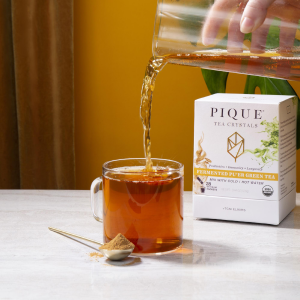
Pique Pu’er Green
Unrivaled polyphenol concentration. Fermented with probiotics. The ultimate supertea for immune support and cellular health.
5. White Tea
White tea is created from new buds and young leaves of the Camellia sinensis plant, which helps explain why it has the most delicate flavor profile of all the “true” teas. (24) (The silver hairs on the new buds account for the tea’s whitish hue.) Right after harvesting, these buds and leaves are steamed or fried to stop the oxidation process. Then the leaves are dried.
This style of processing leads to a light, delicate, and fruity flavor. White tea is also lower in caffeine than other “true” teas.
Different types of white tea include (25):
- Bai Hao Yin Zhen (aka Silver Needle), which is a rare tea made only from buds. It has a floral scent and sweet flavor.
- Bai Mu Dan (aka White Peony), which has a slightly stronger flavor than Silver Needle thanks to the inclusion of young leaves as well as buds.
- Darjeeling White tea, which is grown in India and is usually less expensive than white teas grown in Yunnan.
- Gong Mei (aka Tribute Eyebrow), which is derived from more mature leaves and has a richer, earthier flavor than most other styles of white tea.
- Shou Mai (aka Long Life Eyebrow), which also is derived from more mature leaves and undergoes a longer oxidation process than other types of white tea.
Benefits of White Tea
Because it’s minimally processed, white tea is thought to have especially high levels of good-for-you catechins. It also boasts plenty of other health benefits:
- It has antioxidant properties, meaning it can potentially help protect against oxidative stress (26)
- It may help support the body’s response to inflammation (27)
- It may help support dental health thanks to the fact that it contains fluoride, catechins, and tannins. Fluoride is known to support teeth strength, while catechins and tannins may support the management of plaque bacteria in the mouth (28, 29, 30)
- It may help support brain health (31)
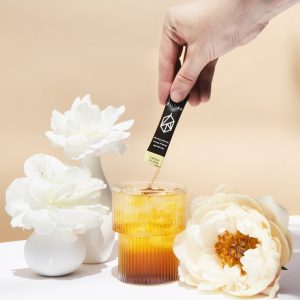
Pique White Peony
Queen of teas. Rare and superior antioxidant content. Reliable immune support + energy.
Different Types of Herbal Teas
As noted above, herbal teas (also known as “tisanes”) aren’t technically “true” tea types. But they’re brewed and consumed in the same way as the teas outlined above, and they’re beloved among tea drinkers of all stripes. So we’d be remiss if we excluded them from this list!
Here’s a look at some of the most popular herbal brews and their health benefits.
1. Chamomile Tea
Chamomile is a pretty, elegant, and fragrant herb that belongs in the Asteraceae plant family. (32) People have been using chamomile for therapeutic purposes for centuries, and today it’s a popular tea—especially among people who are looking to unwind before bed. Chamomile tea is made from the dried flowers of the chamomile plant.
There are two primary varieties of chamomile: German Chamomile and Roman Chamomile (which is sometimes called English Chamomile). (33) They’re different species of the same plant, though they grow a bit differently and have a slightly different appearance.
The Benefits of Chamomile Tea
Per a comprehensive 2010 review, chamomile may offer the following benefits (34):
- It may support calm and perhaps support healthier sleep habits. (35)
- It may support digestion.
2. Ginger Tea
The spicy root (or “rhizome”) of the ginger plant belongs to the same family as healthful spices such as cardamom and turmeric. (37) It adds flavor to a huge variety of dishes and drinks, and people have been using it for therapeutic purposes for thousands of years. (38) It also makes for a delicious and healthful tea.
Benefits of Ginger Tea
Many of ginger tea’s health properties stem from compounds called gingerols and shogaols. These compounds aren’t just fun to pronounce; they also seem to help support the body’s response to inflammation. (39)
Ginger is also well-known for helping with nausea and helping people cope with motion sickness.
3. Hibiscus Tea
Not surprisingly, hibiscus tea is derived from the hibiscus plant. (40) This plant grows native in North Africa and Southeast Asia and can be found in tropical and subtropical climates around the globe.
The red brew is simultaneously sweet and tart (think of it like the tea equivalent of cranberry juice). It’s commonly enjoyed as an iced tea and is a fantastic and refreshing summer drink.
Benefits of Hibiscus Tea
Hibiscus doesn’t have the same “superfood” reputation as some other teas on this list, but maybe it should. Research suggests this pretty plant is packed with potential benefits:
- It’s high in antioxidants (41) (42)
- It may support healthy cholesterol management (43) (44)
- It may help support liver health (45) (46) (47)
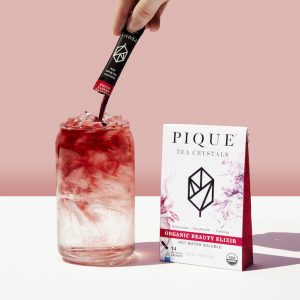
Pique Hibiscus Beauty Elixir
Like a rosy-cheeked glow that’ll have you feeling flirty. Revitalizing and caffeine-free. Make your cells dance.
4. Mint Tea
Peppermint tea is perhaps the most popular herbal tea around and is used in a myriad of different herbal infusions. This minty brew—which is derived from the leaves of the mint plant—smells and tastes great and is commonly used to settle an upset stomach. In fact, it’s been used for its great taste and its health benefits for thousands of years. (48)
Benefits of Mint Tea
Much of the research into the possible benefits of peppermint has focused on peppermint oil instead of peppermint tea. (49) That said, because peppermint leaves contain peppermint oil, it’s possible mint tea may deliver some of the same benefits as peppermint in oil form. For instance:
- It may support digestion and may help make your belly feel a little better. Animal studies suggest mint can help support relaxation in the digestive system and help ease spasms in the gut. (50) (51)
- Even though it’s caffeine-free, peppermint tea might have a natural energizing effect. One 2005 study found the scent of peppermint may reduce feelings of sleepiness. (55) In another small study, participants reported feeling less fatigued while taking a cognitive test when they consumed peppermint oil. (56)
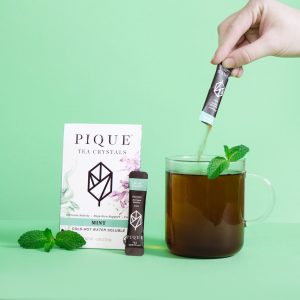
Pique Mint Herbal
Wake up your senses with a tongue-tingling burst of cool, glacial spearmint. Pure and refreshing.
5. Rooibos Tea
This caffeine-free herbal tea is well-known for its rich, red hue and sweet, earthy, slightly floral flavor. (Not coincidentally, rooibos is also sometimes called “red tea” or “red bush tea.”) It’s derived from the fermented leaves of the Aspalathus linearis shrub, which grows natively in South Africa. (57)
Benefits of Rooibos Tea
Like hibiscus, rooibos doesn’t have a major reputation as a health food. But it should! While research into rooibos is still ongoing, so far studies suggest that:
- It’s loaded with antioxidant compounds (including aspalathin, nothofagin, and quercetin), which may help support protection against oxidative stress. (58)
- It may help support heart health. (59) (60) (61)
- It may help support strong teeth and bones. Red rooibos is loaded with fluoride minerals as well as calcium and manganese—all of which may help support bone and teeth strength. (62) (63)
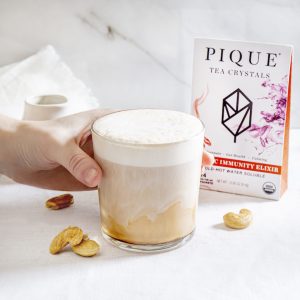
Pique Rooibos Vitality Elixir
Powerhouse of unique plant nutrients. Earthy, caffeine-free and low in tannins. Ideal for sensitive tummies.
The Bottom Line on Different Types of Tea
No matter how you slice (er, drink) it, there’s no doubt that tea’s popularity is here to stay.
Regardless of whether you choose to sip nothing but “true” teas or you’re an herbal fan at heart, the world of tea offers something for every taste bud and caffeine preference. What’s more, both “true” and herbal teas may offer a variety of health benefits.
While this list represents many of the most popular types of tea, there are also plenty of other herbal options to choose from. Use this list as a starting point for exploring the delectable world of tea, and then let your taste buds be your guide.
Whatever variety you go with, you can’t go wrong with a good cup of tea!
